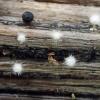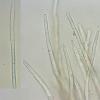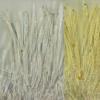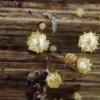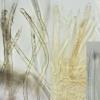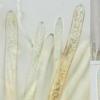
11-11-2025 20:16
Bohan JiaHi, lastly I have found these tiny yellow decayin

09-11-2025 13:20
Hello.A tiny ascomycete, appearing as erupting gra

08-11-2025 00:29
 Francois Guay
Francois Guay
I found this species in Quebec, Canada, on herbace

04-11-2025 09:07
Hello.A suspected Hymenoscyphus sprouting on a thi

04-11-2025 12:43
 Edvin Johannesen
Edvin Johannesen
Hi! One more found on old Populus tremula log in O
White hairy on Angelica
Stefan Jakobsson,
04-05-2021 23:47
In the mean time I'd be happy for ideas on what it could be.
Hans-Otto Baral,
05-05-2021 11:14

Re : White hairy on Angelica
Trichopeziza mollissima I think.
Stefan Jakobsson,
15-05-2021 00:56
Re : White hairy on Angelica
Yes, thank you. Now when it has grown bigger it is definitely T. mollissima.
However, on the same culm there is now also another species with more yellowish hairs even if not as bright yellow as the one I have interpreted to be T. limonipilosa. The spores are 10.4 - 15.0 × 1.9 - 2.3 µm, with virtually no visible spore content. IKI faintly bluish, no croziers. Would this be T. sulphureopilosa?
Mirek Gryc,
15-05-2021 08:24
Re : White hairy on Angelica
Hi
These two species are very often found together.
If these are two separate species? As far as I know, work on them has not yet been completed. Zotto knows much more on this subject.
I am wondering, however, a blue reaction to iodine?
Such occurs after pre-treatment of asci in KOH.
Are you sure she was blue?
greetings
Mirek
These two species are very often found together.
If these are two separate species? As far as I know, work on them has not yet been completed. Zotto knows much more on this subject.
I am wondering, however, a blue reaction to iodine?
Such occurs after pre-treatment of asci in KOH.
Are you sure she was blue?
greetings
Mirek
Stefan Jakobsson,
17-05-2021 12:50
Mirek Gryc,
17-05-2021 14:38
Re : White hairy on Angelica
Hi Stefan
I only asked out of curiosity.
Porus Reaction T. mollissima and T. sulphureopilosa should be red.
Maybe this species is more complex than we think?
Or maybe you have a different genre?
Porus Reaction T. mollissima and T. sulphureopilosa should be red.
Maybe this species is more complex than we think?
Or maybe you have a different genre?
Mirek
Hans-Otto Baral,
17-05-2021 16:18

Re : White hairy on Angelica
I remember a RB reaction in this group. Blue at low IKI concentration, dirty red at high.
After KOH there is only blue, of course (definition of hemiamyloidity).
Mirek Gryc,
17-05-2021 18:36
Re : White hairy on Angelica
Hi Zotto
So do you think Stefan used IKI in a low concentration?
Using after Lugol, KOH with low concentration, I also obtained a blue reaction.
How I will find fresh ascomata, I will check more closely.
Thank you Zotto.
So do you think Stefan used IKI in a low concentration?
Using after Lugol, KOH with low concentration, I also obtained a blue reaction.
How I will find fresh ascomata, I will check more closely.
Thank you Zotto.
Hans-Otto Baral,
18-05-2021 08:09

Re : White hairy on Angelica
Every hemiamyloid nreaction is blue whenever the fungus was KOH-pretreated. Then there is no chance to distinguish it from euamyloid reactions.
A low concentration of Lugol is a frequent case, yes i assume.

